Journal Club: New species of barbet discovered in Peru
Sira barbet, Capito fitzpatricki, Seeholzer, Winger, Harvey, Cáceres & Weckstein, 2012, photographed at the Río Shinipo locality in Cerros del Sira in the Ucayali Region, Peru (South America).
Image: Michael G. Harvey/Cornell University, 4 November 2008 [velociraptorise].
Canon EOS 20D, 1/250 sec, f/8.0, 400 mm, iso:400
.. .. .. .. .. .. .. .. .. .. ..
This is a Sira barbet, Capito fitzpatricki, a recently-discovered and newly-described member of the American barbet family, Capitonidae. Barbets, close relatives to the toucans, are small, chubby and colourful near-passerines that live in moist forests throughout much of Central and South America. Barbets are residential frugivores and insectivores.
 The Sira barbet was discovered in the montane cloud forest in the upper Rio Tzipani watershed in the Cerros del Sira range of the eastern Andes (figure 1).
The Sira barbet was discovered in the montane cloud forest in the upper Rio Tzipani watershed in the Cerros del Sira range of the eastern Andes (figure 1).
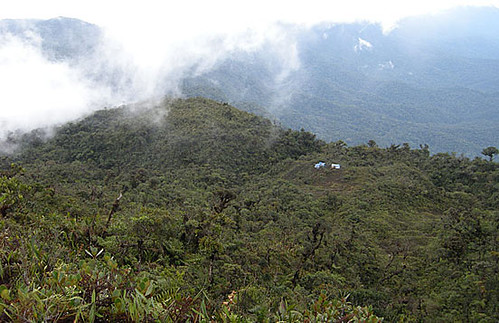
Figure 1. Montane cloudforest of the Cerros del Sira range of the eastern Andes in Peru.
.. .. .. .. .. .. .. .. .. .. ..
This new species was discovered on 8 October 2008 during an expedition led by Michael Harvey, Glenn Seeholzer, and Benjamin Winger, who were senior-level ornithology undergraduates at Cornell University at the time.
“[T]his incredibly biodiverse region had received very few visits from ornithologists or other biologists, and very little was known to ornithologists about the birds that are found there,” writes co-discoverer Mr Winger in email. Mr Winger is currently in graduate school at the University of Chicago.
“Therefore the goal of our trip was to travel on foot through as many different habitats and elevations of the Sira mountains as possible, recording and documenting the birds we found along the way at each camp location.”
They were accompanied by the skilled Peruvian field biologist Daniel Cáceres, a graduate of the Universidad Nacional de San Agustín in Arequipa, Peru, and by local Ashéninka guides.
“On the day we found the barbet, we were actually getting ready to leave the field,” recalls Mr Winger. “We had been trekking and camping in remote cloud forest for nearly three weeks, our food supply was dwindling, and two of us had minor injuries that needed medical attention. While scouting for locations where we could make a new camp that night, the team entered a lower-elevation forest that we had not previously visited during the expedition.”
This is where they first spied the bird.
“It was sitting about 60 feet up on a bare branch,” said Mike Harvey in a press release. Mr Harvey, now a graduate student at Louisiana State University, was first to spot the new species. Mr Seeholzer had the good luck, steady hands and binoculars necessary to snap a “digibinned” photograph of the bird during this exciting moment of discovery by holding a point-and-shoot camera up to his binoculars, which was the only camera that the team had easily accessible at that moment (figure 2):
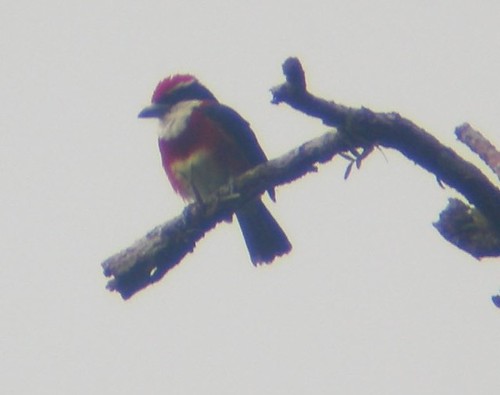
Figure 2. “Digibinned” photograph of the Sira barbet, Capito fitzpatricki, at the moment of discovery on 8 October 2008.
.. .. .. .. .. .. .. .. .. .. ..
“At first we thought it was the scarlet-banded barbet (Capito wallacei), but the more we looked at it, the more we saw obvious differences in its plumage.”
Although the Sira barbet closely resembles the scarlet-banded barbet, it is distinguished by its slightly larger overall size and by differences in colour and pattern on the bird’s flanks, lower back, thighs, and breast (side-by-side comparison between C. wallacei and C. fitzpatricki: figure 3).
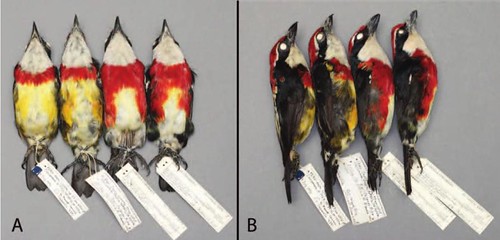
Figure 3. (A) Ventral and (B) lateral view of (from left to right) Capito wallacei (male, LSUMZ 161647), holotype of C. wallacei (female, MUSM 21269), holotype of C. fitzpatricki (female, AU-CORBIDI 2793), and C. fitzpatricki (male, AU-CORBIDI 2192).
.. .. .. .. .. .. .. .. .. .. ..
As you can see in the above image, the scarlet flanks are the most obvious diagnostic field mark that distinguishes these two species.
Location is also good species clue. Both taxa have non-overlapping ranges within severely limited and narrow elevational zones; the scarlet-banded barbet only occurs on a mountain ridge located 440km to the north.
The team soon realised this bird was distinct and thus probably new to science.
“It was an incredibly exciting day,” recalls Mr Winger. “Fortunately, we were able to get back to town, restock on food and recuperate [from] our injuries, and return to the field to learn more about this spectacular bird.”
Upon returning to the site, they collected eight specimens, prepared study skins (figure 4) and tissue samples, and made many recordings of the bird’s vocalisations. Their Ashéninka guides, who were familiar with this bird’s habits and life history, provided additional detail to the team’s behavioural observations, which are reported in their recently published paper (doi:10.1525/auk.2012.11250).
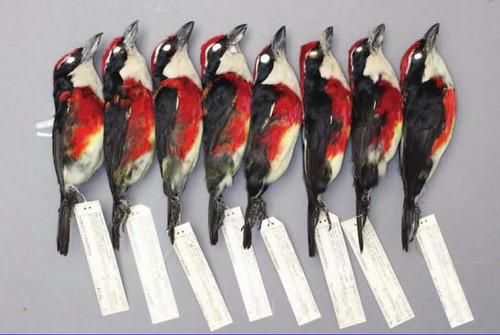
Figure 4. Lateral views of the type series of Capito fitzpatricki: (from right to left) CU 53125 (female), CU 53126 (female), AU-CORBIDI 2793 (female; holotype), KUNMH 117326 (female), KUNMH 117325 (male), AU-CORBIDI 2792 (male), AU-CORBIDI 2796 (male), and AU-CORBIDI 2795 (subadult male). The subadult male shows paler red flanks compared to the rest of the series and had incomplete skull ossification.
.. .. .. .. .. .. .. .. .. .. ..
Phylogenetic studies using several mitochondrial and nuclear genes currently being conducted by co-author Jason Weckstein at The Field Museum in Chicago, indicate that the scarlet-banded and Sira barbets are reciprocal sister species — each other’s closest relatives.
The bird’s common name is in honour of the Cerros del Sira range where it was discovered, whilst its specific scientific name, fitzpatricki, honours Cornell Lab of Ornithology executive director, John Fitzpatrick, who discovered and named six new species of birds in South America.
“Fitz has inspired generations of young ornithologists in scientific discovery and conservation,” said Mr Winger. “He was behind us all the way when we presented our plan for this expedition.”
Besides the fact that this bird is a new species to science, I am excited and fascinated by these sister species’ close proximity. The close geographical proximity of two closely-related yet distinct species indicates that the local topography is very complex, with many small, separate habitats that are isolated from each other by steep ridges, rivers, canyons and other formations. Such isolation makes gene flow unlikely between two populations, which leads to divergence and speciation over time.
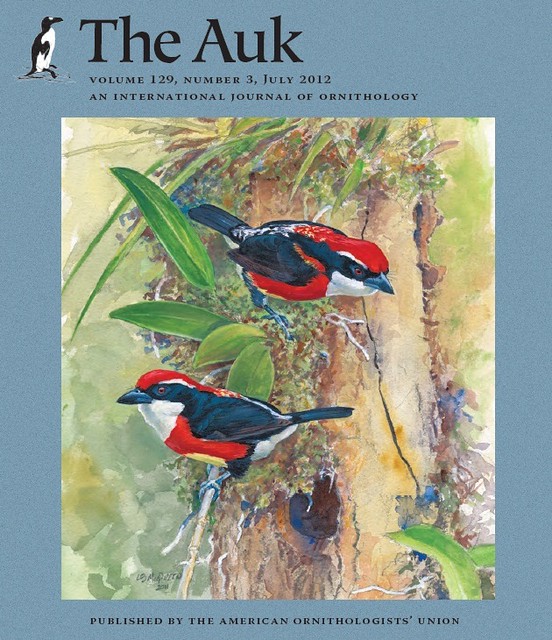
Sources:
Glenn F. Seeholzer, Benjamin M. Winger, Michael G. Harvey, Daniel Cáceres A. & Jason D. Weckstein (2012). A new species of barbet (Capitonidae: Capito) from the Cerros del Sira, Ucayali, Peru. Auk, 129 (3), 551-559. doi:10.1525/auk.2012.11250 [free PDF]
Ben Winger: emails, 7, 8 & 9 August 2012.
Cornell University Press Release.
Thanks also to Pat Leonard from Cornell University’s communications department for providing me a copy of the Auk PDF and for sending the URL linking to photographs of the bird’s habitat.
see also:
John P O’Neill, Daniel F Lane, Andrew W Kratter, Angelo P Capparella & Cecilia Fox Joo. (2000). A striking new species of barbet (Capitoninae: Capito) from the eastern Andes of Peru. Auk, 117 (3), 569-577. doi:10.1642/0004-8038(2000)117[0569:ASNSOB]2.0.CO;2 [free PDF]
How to see the Sira Barbet by Gunnar Engblom here on Birdingblogs https://birdingblogs.com/2012/Gunnar/how-to-see-the-sira-barbet
.. .. .. .. .. .. .. .. .. .. ..
NOTE: slightly modified from this story, originally published in The Guardian under a different title.
.. .. .. .. .. .. .. .. .. .. ..
twitter: @GrrlScientist
facebook: grrlscientist
evil google+: grrlscientist
email: grrlscientist@gmail.com
